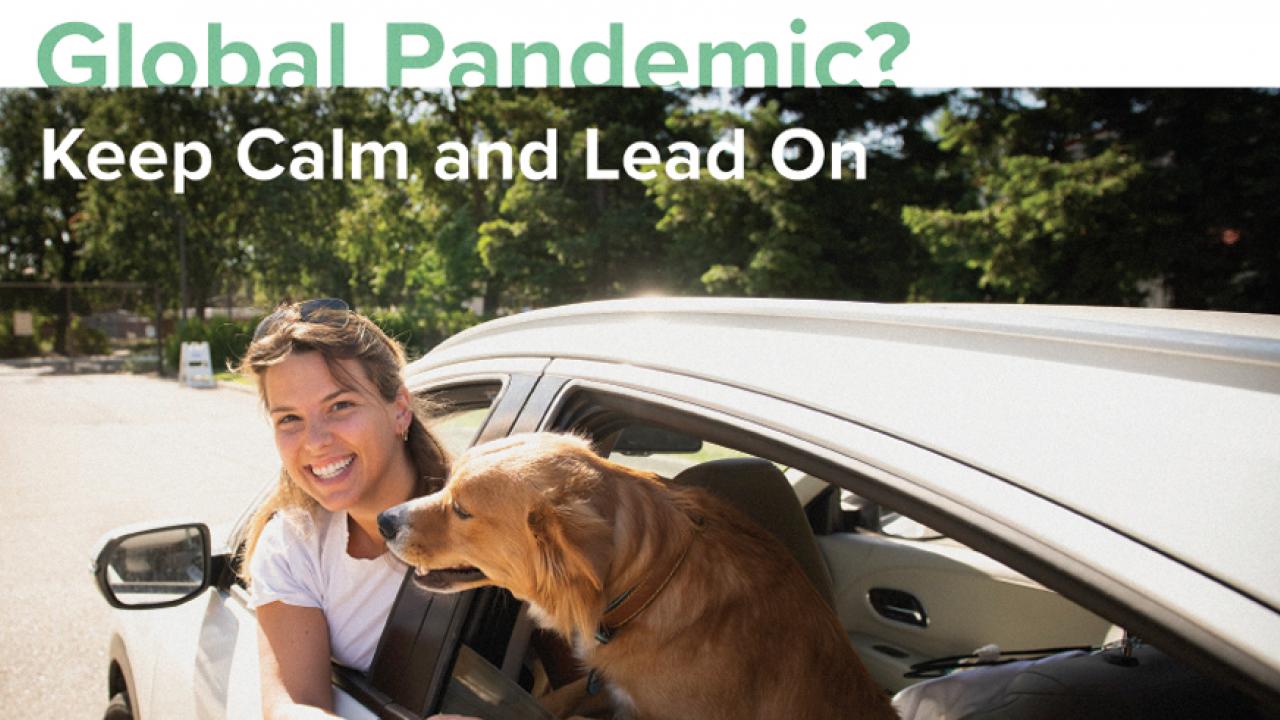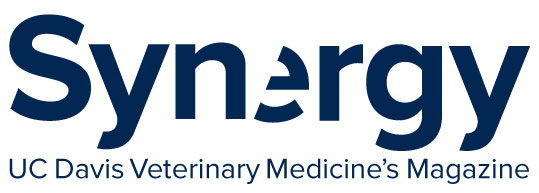
Global Pandemic - Keep calm and Lead on - Fall 2020
UC Davis Veterinary Medicine maintains a mission-first attitude while addressing and adapting to COVID-19-related challenges.
If our veterinary medicine community had to choose a word for 2020, it may well be pivot. When the SARS-CoV-2 coronavirus became a worldwide pandemic in mid-March and California issued shelter-in-place orders, we changed the way we do everything – from seeing animal patients and clients in the hospital to teaching DVM students to hosting research conferences.

Continuing to Serve the Community
On March 19, the veterinary hospital closed for appointments other than emergencies and critical care treatments, such as chemotherapy. We were one of very few 24/7 emergency facilities in Northern California to remain open. Because of this, the ER received a record number of patients.
Due to physical distancing guidelines, however, clients were no longer allowed in the building. Instead, they were instructed to use the emergency call boxes in the parking lots and were met by hospital staff at their vehicles. Technicians transported patients into the hospital, and all client communications were conducted by phone.
By mid-May, the hospital re-opened some of its 30+ specialty services. The client services team set up a patient check-in area at the hospital’s front doors and established a temporary waiting room in a nearby campus building that allowed for proper physical distancing. This system remains in place.
Maintaining Excellence in Teaching
To ensure continuity of veterinary training while safeguarding student health and well-being, the faculty revamped curriculum delivery for all educational activities – in the classroom, lab and clinic. Transitioning to distance learning platforms for lectures, discussions and laboratories for first- through third-year students was straightforward for some sessions, and required creative new media and approaches for others. For most faculty members, instruction using video conferencing tools was novel territory, and this pivot required the rapid acquisition of skills.
The curriculum committee recognized the high level of stress and anxiety among students during a period they would be studying for their Comprehensive Year Two Exam. To allow more flexibility, the exam was offered on two dates – one in late May and another in July. The committee also recommended that students be temporarily allowed to select between “pass/no pass” or traditional letter grading for the remaining spring semester courses.
“We believe this helped mitigate any actual or perceived negative effects on our students due to the rapid change in instructional modalities,” said Dr. Joie Watson, associate dean for professional education.
Third-year students experienced a delay in transitioning to their clinical training year. Normally, the 4th clinical year for a DVM student at UC Davis spans 58 weeks and begins in mid-April. Due to the need for physical distancing and personnel restrictions in the hospital, the Class of 2021’s on-site clinical year was delayed until June 8. Those eight weeks included coursework, as well as clinical rotations delivered through distance learning platforms. All core clinical rotations have resumed as either hybrid in-person or full participation experiences.
During the Yolo County shelter-in-place order, without access to on-site learning in the hospital, the fourth-year students were provided alternative methods for clinical training to augment their academic records to satisfy degree requirements under governance of the University of California and the American Veterinary Medical Associational Council on Education. Their records were analyzed for remaining core requirements, and students were transitioned to “virtual rotations” that allowed them to observe clinical examinations and procedures online.
For example, Dr. Betsy Vaughan taught students on the Large Animal Ultrasound Service rotation through video chatting, allowing them to gain the same level of knowledge as if they were present. Dr. Mary Beth Whitcomb has done this in the past to consult with U.S. and international veterinarians to help them through difficult scans in real time. Lab classes still occur in person, but the number of students in each lab session has been decreased in order to increase physical distance. The academic teams even reviewed such factors as air circulation in each room to help determine capacity limits.
“We know this has been a trying and unpredictable time for all of our DVM students,” Watson said. “We’ve worked hard to ensure that each student is able to fulfill their expectations of a quality veterinary medical education on a timeline that fits with their personal risk assessment.”
Dr. Karl Jandrey, associate dean of admissions and student programs, worked closely with Watson and the school’s two counselors to meet with individual students and hold virtual town hall meetings with entire classes to be sure the faculty were meeting student needs and keeping them informed of the changes and updates to their studies. Thanks to donors, the school also offered emergency financial resources for any student who needed additional assistance.
Research Conferences Go Virtual

Professional conferences are an ideal time to network with colleagues over meals and happy hours. Even though the face-to-face aspect of the West Coast Veterinary Pathology Conference was missed this year, the shift to an online format broadened meeting participation to host international researchers.
When faced with the possibility of having to cancel the conference’s 37th annual gathering, Becky Griffey and Drs. Kevin Keel and Denise Imai quickly shifted to bring the conference online. Thanks to their collaborative teamwork and flexibility, the show went on with 30 case presentations, including at least nine veterinary student presenters.
“The conference became a fantastic opportunity to showcase pathology to veterinary students and introduce residents to their colleagues across the country,” said Dr. Noel Dybdal, one of the school’s recent distinguished alumni achievement award winners. “The presentations all included truly board-worthy examples and work ups. Having attended this conference from the beginning (if maybe not every year), I can say it was the best yet and certainly a wonderful reflection of the world’s number one veterinary school. Hats off to the team for their ability to pivot and pull off a great conference.”
At the end of May, the school’s research committee, in collaboration with the Office of Research and Graduate Education, held a virtual Research Expo to discuss various aspects of COVID-19 research. The school’s research and expertise has been prominent during the pandemic, garnering worldwide media coverage.
Dean Michael Lairmore provided opening remarks for the expo and Joseph DeRisi, PhD, Professor and Co-President of the Chan Zuckerberg Biohub at UCSF, gave a keynote in which he discussed two intense, geographical surveys for COVID-19, conducted in the relatively isolated community of Bolinas, and an urban neighborhood in San Francisco’s Mission district. The studies helped provide valuable information for modeling community surveillance of the disease. Data will also be helpful in evaluating when it is safe to discontinue community containment and return to work, school and more normal activities.
Dr. Isaac Pessah provided updates on cross- disciplinary collaborations tackling some of the major questions of SARS-CoV-2, the coronavirus that causes COVID-19. Dr. Chris Miller with the California National Primate Research Center explained the value of having the center as a unique resource for studying COVID-19 in terms of vaccine development and developing diagnostics.
Dr. Christine Kreuder Johnson relayed what it has been like to be on the frontlines of COVID-19 response around the world. And Dr. Jane Sykes, Chief Veterinary Medical Officer of the veterinary hospital, discussed the emerging issue of the susceptibility of domestic animals to infection from SARS-CoV-2.
While there’s no doubt that our students, staff and faculty miss having more in-person connection, a certain camaraderie has developed as we navigate zoom meetings with interruptions from barking dogs and curious kids.
“I couldn’t be more proud to see the way everyone in our community has improvised and expanded our skill sets to continue providing the best in patient care, research and teaching,” said Dean Michael Lairmore. “It will be interesting to see what we adopt permanently from these adjustments to make our activities even stronger.”
